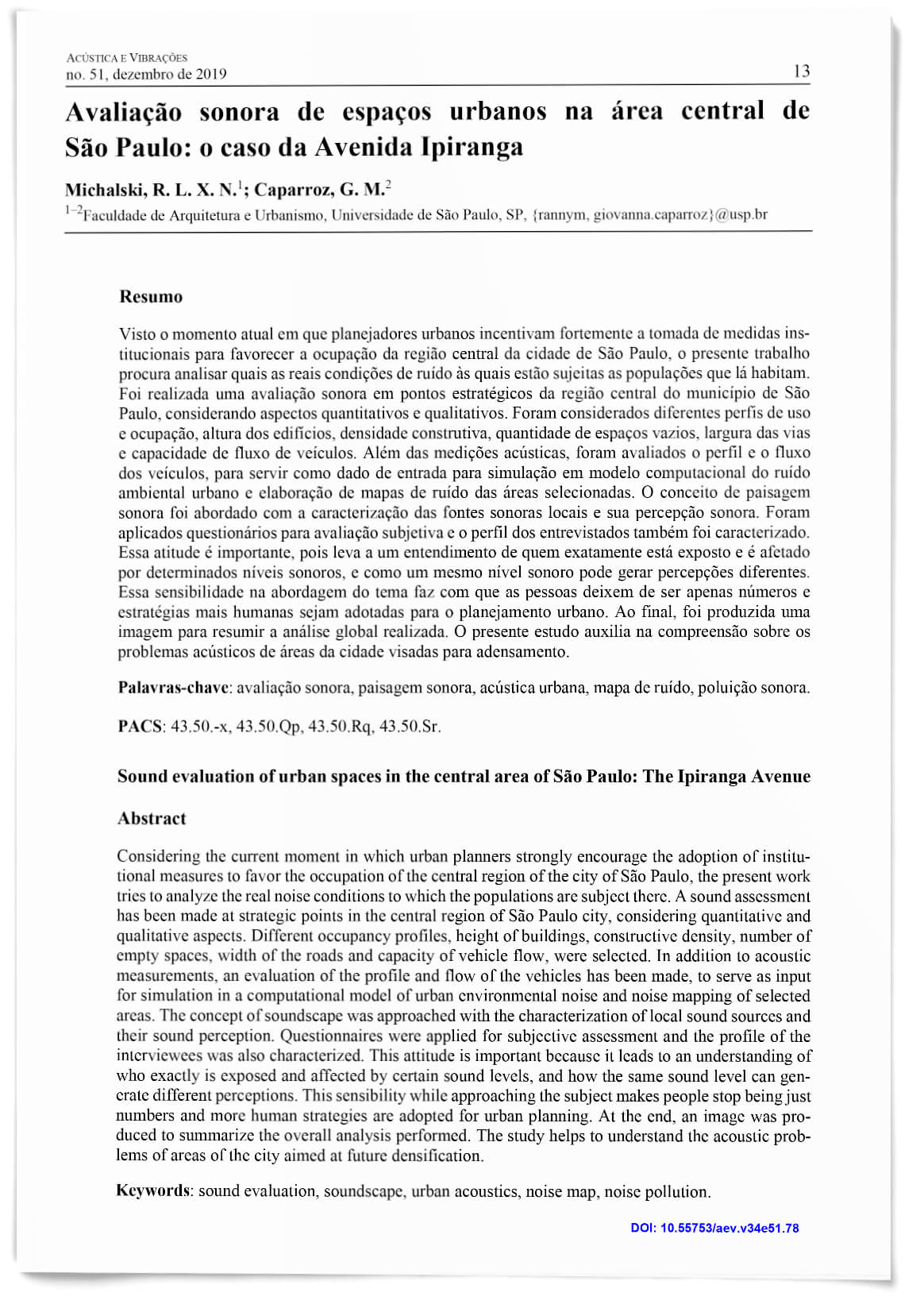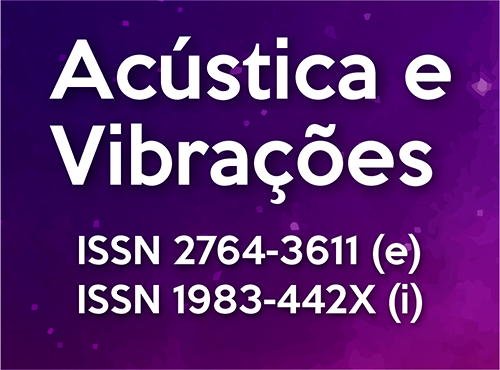Sound evaluation of urban spaces in the central area of São Paulo: The Ipiranga Avenue
DOI:
https://doi.org/10.55753/aev.v34e51.78Keywords:
sound evaluation, soundscape, urban acoustics, noise map, noise pollutionAbstract
Considering the current moment in which urban planners strongly encourage the adoption of institutional measures to favor the occupation of the central region of the city of São Paulo, the present work tries to analyze the real noise conditions to which the populations are subject there. A sound assessment has been made at strategic points in the central region of São Paulo city, considering quantitative and qualitative aspects. Different occupancy profiles, height of buildings, constructive density, number of empty spaces, width of the roads and capacity of vehicle flow, were selected. In addition to acoustic measurements, an evaluation of the profile and flow of the vehicles has been made, to serve as input for simulation in a computational model of urban environmental noise and noise mapping of selected areas. The concept of soundscape was approached with the characterization of local sound sources and their sound perception. Questionnaires were applied for subjective assessment and the profile of the interviewees was also characterized. This attitude is important because it leads to an understanding of who exactly is exposed and affected by certain sound levels, and how the same sound level can generate different perceptions. This sensibility while approaching the subject makes people stop being just numbers and more human strategies are adopted for urban planning. At the end, an image was produced to summarize the overall analysis performed. The study helps to understand the acoustic problems of areas of the city aimed at future densification.
References
BABISCH W. The noise/stress concept, risk assessment and research needs. Noise & Health; Volume 4, Issue 16, pp 1-11, 2002. Disponível em: https://pubmed.ncbi.nlm.nih.gov/12537836/
KANG, J.; SCHULTE-FORTKAMP, B. Soundscape and the Built Environment. 1. Ed., CRC Press, 2017. ISBN 9781138893085. doi: 10.1201/b19145 DOI: https://doi.org/10.1201/b19145
WORLD HEALTH ORGANIZATION. Guidelines for Community Noise. 1999. Disponível em: http://whqlibdoc.who.int/hq/1999/a68672.pdf.
BARING, J. G. de A. Controle da Poluição Sonora: planejamento de pesquisas nas universidades brasileiras, tendo em vista a experiência da cidade de São Paulo. In: XXII Encontro da Sociedade Brasileira de Acústica, SOBRAC 2008. Belo Horizonte, MG, 2008.
SÃO PAULO (Município). Lei Nº 8.106, de 30/09/1974, Sons urbanos, São Paulo, 1994. 6. SÃO PAULO (Município). Decreto Nº 11.467, de 30/10/1974. Regulamenta a lei 8106 de 30/09/1974, que dispõe de sons urbanos, São Paulo, 1994.
BRASIL. Ministério do Trabalho. Portaria Nº 3.214, de 08/06/78 – NR 15 – Anexos 1 e 2. Limites de nível de ruído nos ambientes de trabalho, Brasília, 1978.
BRASIL. CONAMA (Conselho Nacional do Meio Ambiente). Resolução Nº 1, de 08/03/90: Emissão de ruídos. Brasília, 1990.
BRASIL. CONAMA (Conselho Nacional do Meio Ambiente). Resolução Nº 2, de 08/03/90: Programa Nacional de Educação e Controle da Poluição Sonora – Silêncio. Brasília, 1990.
SÃO PAULO (Município). Decreto-lei Nº 11.501, de 11/04/1994. Controle e a fiscalização das atividades que gerem poluição sonora, São Paulo, 1994.
SÃO PAULO (Município). Decreto-lei Nº 34.569, de 6/10/1994. Programa Silêncio Urbano - PSIU, São Paulo, 1994.
SÃO PAULO (Município). Lei Nº 16.402, de 22/03/2016. Lei de Parcelamento, Uso e Ocupação do Solo de São Paulo. São Paulo, SP, 2016.
SÃO PAULO (Município). Decreto-lei Nº 16.499, de 20/06/2016. Elaboração do Mapa do Ruído Urbano da Cidade de São Paulo e dá outras providências. Diário Oficial do Município de São Paulo. São Paulo, SP, 20 jul. 2016.
HOLTZ, M. C. de B., Avaliação qualitativa da paisagem sonora de parques urbanos. Estudo de caso: Parque Villa Lobos, em São Paulo. Dissertação (Mestrado) — Faculdade de Arquitetura e Urbanismo, Universidade de São Paulo, São Paulo, 2012. doi: 10.11606/D.16.2012.tde-02072012-143458 DOI: https://doi.org/10.11606/D.16.2012.tde-02072012-143458
CORTÊS, M. M. Método de avaliação sonora em áreas urbanas formais e informais. Tese (Doutorado) — Faculdade de Arquitetura e Urbanismo, Universidade Federal do Rio de Janeiro, Rio de Janeiro, 2018. Disponível em: https://proarq.fau.ufrj.br/teses-e-dissertacoes/971/metodo-de-avaliacao-sonora-em-areas-urbanas-formais-e-informais
MARIE CURIE ACTIONS. Urban Sound Planning: The SONORUS project. Chalmers University of Technology, Suécia, 2016. Disponível em: https://publications.lib.chalmers.se/records/fulltext/242257/local_242257.pdf
HONG, J.; JEON, J. Y. Relationship between spatiotemporal variability of soundscape and urban morphology in a multifunctional urban area: A case study in Seoul, Korea. Building and Environment. v. 126, p. 382 – 395, 2017. Disponível em: doi: 10.1016/j.buildenv.2017.10.021. DOI: https://doi.org/10.1016/j.buildenv.2017.10.021
ISO (International Organization for Standardization). ISO 12913-1. Acoustics – Soundscape – Part 1: Definition and conceptual frameworks, Genebra, 2014.
ISO (International Organization for Standardization). ISO/TS 12913-2. Acoustics – Soundscape – Part 1: Data collection and reporting requirements, Genebra, 2018.
ISO (International Organization for Standardization). ISO/TS 12913-3. Acoustics – Soundscape – Part 1: Data analysis, Genebra, 2019.
ABNT (Associação Brasileira de Normas Técnicas). ABNT NBR 10151, Acústica – Medição e avaliação de níveis de pressão sonora em áreas habitadas – Aplicação de uso geral. Rio de Janeiro, 2019.
DATAKUSTIK. CadnaA software. Disponível em: http://www.datakustik.com/en/products/cadnaa. Acesso em: 20 out. 2019.
GEOSAMPA, Mapa Digital da Cidade de São Paulo. Disponível em: http://geosampa.prefeitura.sp.gov.br. Acesso em: 10 jul. 2019.
ISO (International Organization for Standardization). ISO 80000-8. Quantities and units - Part 8: Acoustics, Genebra, 2007.
ABNT (Associação Brasileira de Normas Técnicas). ABNT NBR 16313, Acústica – Terminologia. Rio de Janeiro, 2014.
BISTAFA, S. R. Acústica aplicada ao controle do ruído. São Paulo: Blucher, 2006. ISBN 9788521212836.
YANG, W.; KANG, J. Soundscape and Sound Preferences in Urban Squares: A Case Study in Sheffield. Journal of Urban Design, v. 10, no. 1, p. 61 – 80, 2005. doi: 10.1080/13574800500062395 DOI: https://doi.org/10.1080/13574800500062395

Downloads
Published
How to Cite
Issue
Section
License
Copyright (c) 2019 Acústica e Vibrações

This work is licensed under a Creative Commons Attribution-NonCommercial-ShareAlike 4.0 International License.




